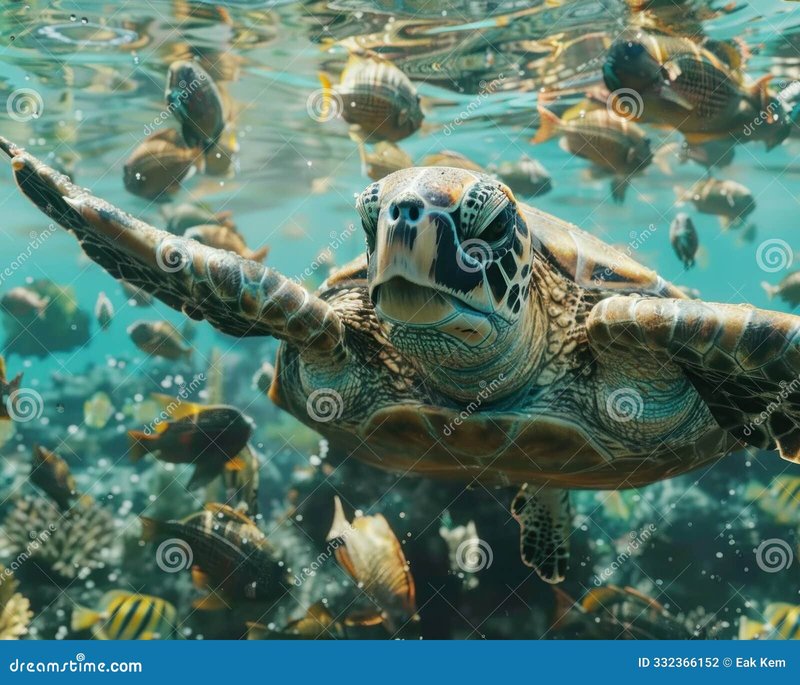
Imagine the ocean as a vast playground filled with hidden treasures, but also challenges. Sea turtles are like seasoned explorers who have learned to read the environment around them. They navigate using various cues, such as the Earth’s magnetic field, the position of the sun, and even the stars. When it comes to communication, these creatures emit sounds and use body language that might seem subtle to us, but is vital for their survival. So, grab a cup of coffee, and let’s explore how sea turtles navigate and communicate in their oceanic home!
The Magnificent Journey: How Sea Turtles Navigate
Sea turtles are known for their impressive long-distance migrations, often traveling thousands of miles between feeding and nesting grounds. But how do they manage to navigate such vast distances? The answer lies in their ability to sense the Earth’s magnetic field. Just like a built-in GPS, these turtles have specialized cells in their eyes that help them detect magnetic fields. This sensory ability is akin to having a sixth sense, guiding them through the deep blue.
Alongside magnetic sensing, sea turtles also rely on other environmental cues. They can perceive the sun’s position during the day, using it as a compass. At night, stars serve a similar purpose. Picture this: a young turtle emerges from its nest on a sandy beach and instinctively heads toward the horizon. It uses the light of the moon and stars to steer its course. It’s an incredible feat of nature!
Another fascinating aspect is their awareness of ocean currents. Sea turtles can detect water temperature changes and currents, using these to plan their route. Picture a sailor adjusting sails according to the wind. Turtles do something similar—using the currents to propel them along their journey while conserving energy. This incredible blend of biological tools makes sea turtles expert navigators of the oceans.
Communication: The Silent Language of Sea Turtles
While sea turtles may not “speak” like humans do, they certainly have their own ways of communicating. These methods range from subtle sounds to body movements. Imagine a gathering of friends where everyone knows just how to respond without saying a word; that’s how sea turtles interact.
One primary mode of communication involves vocalizations. While underwater, sea turtles can produce a variety of sounds—like hisses, grunts, and clicks. These sounds can convey different messages, such as distress or mating signals. It’s a bit like how we might shout or whisper depending on the situation. For instance, a nesting female might produce sounds to alert nearby males, signaling that she’s ready to mate.
Body language plays a significant role too. When sea turtles are interacting with one another, they’ll often engage in gentle nudges or other subtle movements. This behavior helps establish social bonds or indicate readiness to mate. Imagine a quick friendly tap on the shoulder—it’s simple, yet effective.
Moreover, sea turtles can also “communicate” through their physical presence. For example, when they gather in areas with plenty of food, it can signal to others that the spot is worth visiting. This subtle form of communication through visibility is essential for survival and reproduction.
Understanding the Role of Environmental Cues
Environmental cues are crucial for both navigation and communication among sea turtles. Think of it as a giant board of signs that helps them find their way and interact with one another. Water temperature, salinity, and even the texture of the ocean floor can provide valuable information.
For navigation, sea turtles can sense changes in water temperature, which can indicate different currents or feeding areas. Imagine walking on a beach—when the sand changes underfoot, you instinctively adjust your step. Similarly, turtles can pick up on these subtle changes, helping them decide where to go.
In terms of communication, environmental cues also play a role. Native to their habitats, turtles tend to gather in specific areas during certain times of the year. This behavior often coincides with food availability or breeding seasons, acting as an unspoken invitation for others to join. It’s like a secret club that comes alive when the time is right.
This connection to their environment is key to their survival, shaping not only how they navigate but how they live and thrive in the ocean.
Challenges in Navigation: Threats to Sea Turtles
Despite their amazing abilities, sea turtles face numerous challenges in their journeys and communications. Just like any explorer, they encounter obstacles that can disrupt their natural instincts. Human activities pose significant threats, from pollution and habitat destruction to climate change.
Pollution, particularly plastic waste, is a significant hurdle for sea turtles. They may mistake plastic for food, leading to ingestion that can cause harm. This not only affects their health but can also interfere with their ability to communicate, as they may not reach others due to illness.
Climate change is another major concern. Warmer ocean temperatures can shift habitats and food sources, impacting their navigational cues. Imagine trying to find your way on a road that keeps changing shape—it would be incredibly frustrating and confusing. These alterations can disrupt their migrations and breeding cycles, jeopardizing their populations.
Additionally, habitat loss, particularly in nesting areas, poses a challenge. Coastal developments and erosion can destroy beaches where turtles lay their eggs. Without safe places to nest, future generations of turtles may struggle to survive. So, while these creatures are equipped with incredible navigation and communication skills, they still face uphill battles in our ever-changing world.
Conservation Efforts: Protecting Sea Turtles
Given the challenges sea turtles face, there are concerted efforts globally to protect these majestic creatures. Conservation initiatives aim to preserve nesting beaches, reduce plastic pollution, and ensure safe migration pathways. It’s like creating a protective bubble for them in a world full of obstacles.
Organizations are working to clean up oceans and reduce plastic waste. Community campaigns engage the public to understand the importance of keeping our oceans clean. Additionally, laws are in place in many countries to protect nesting sites during critical seasons. Just like a watchful guardian, these measures help keep the turtles safe as they reproduce.
Public awareness is also crucial. Many initiatives focus on educating people about the threats sea turtles face and how to help. Simple actions, like reducing plastic usage or participating in beach cleanups, can make a significant difference. Engaging local communities creates a collective effort that amplifies the message.
Ultimately, by understanding how sea turtles navigate and communicate, we can better appreciate their role in our oceans and recognize the importance of conserving their habitats. Every small step contributes to the bigger picture of protecting these incredible animals.
Sea turtles are nothing short of fascinating. Their ability to navigate the vast oceans and communicate with one another is a marvel of nature. Using a mix of technology (their biological senses) and instinct, they journey across thousands of miles and engage with each other in ways we’re just beginning to understand.
As we learn more about these creatures, it’s clear that they need our help to continue their incredible journeys. By supporting conservation efforts and minimizing our impact on the environment, we can ensure that sea turtles thrive for generations to come. So, the next time you think of these majestic beings gliding through the sea, remember the adventure they undertake and the silent conversations they share beneath the waves. Together, we can be a part of their story.

